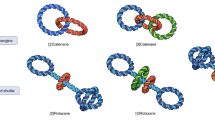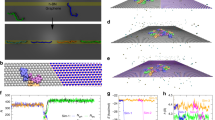Abstract
The development of single-molecule techniques has afforded many new methods for the observation and assembly of supramolecular structures and biomolecular networks. We previously reported a method, known as the single-molecule cut-and-paste approach, to pick up and deposit individual DNA strands on a surface. This, however, required pre-functionalization of the surface with DNA strands complementary to those that were to be picked up and then deposited. Here we show that single molecules of double-stranded DNA, bound to the tip of an atomic force microscope, can be deposited on a bare gold electrode using an electrical trigger (surface potential cycling). The interactions between the DNA and the electrode were investigated and we found that double-stranded DNA chemisorbs to the gold electrode exclusively at its end through primary amine groups. We corroborated this finding in experiments in which only a single adenosine nucleotide on a polyethylene glycol spacer was ‘electrosorbed’ to the gold electrode.
This is a preview of subscription content, access via your institution
Access options
Subscribe to this journal
Receive 12 print issues and online access
$259.00 per year
only $21.58 per issue
Buy this article
- Purchase on Springer Link
- Instant access to full article PDF
Prices may be subject to local taxes which are calculated during checkout




Similar content being viewed by others
References
Duwez, A. S. et al. Mechanochemistry: targeted delivery of single molecules. Nature Nanotech. 1, 122–125 (2006).
Kufer, S. K., Puchner, E. M., Gumpp, H., Liedl, T. & Gaub, H. E. Single-molecule cut-and-paste surface assembly. Science 319, 594–596 (2008).
Puchner, E. M., Kufer, S. K., Strackharn, M., Stahl, S. W. & Gaub, H. E. Nanoparticle self-assembly on a DNA-scaffold written by single-molecule cut-and-paste. Nano Lett. 8, 3692–3695 (2008).
Kufer, S. K. et al. Optically monitoring the mechanical assembly of single molecules. Nature Nanotech. 4, 45–49 (2009).
Boon, E. M., Ceres, D. M., Drummond, T. G., Hill, M. G. & Barton, J. K. Mutation detection by electrocatalysis at DNA-modified electrodes. Nature Biotechnol. 18, 1096–1100 (2000).
Wang, J. From DNA biosensors to gene chips. Nucleic Acids Res. 28, 3011–3016 (2000).
McKendry, R. et al. Multiple label-free biodetection and quantitative DNA-binding assays on a nanomechanical cantilever array. Proc. Natl Acad. Sci. USA 99, 9783–9788 (2002).
Kershner, R. J. et al. Placement and orientation of individual DNA shapes on lithographically patterned surfaces. Nature Nanotech. 4, 557–561 (2009).
Braun, E., Eichen, Y., Sivan, U. & Ben-Yoseph, G. DNA-templated assembly and electrode attachment of a conducting silver wire. Nature 391, 775–778 (1998).
Winfree, E., Liu, F. R., Wenzler, L. A. & Seeman, N. C. Design and self-assembly of two-dimensional DNA crystals. Nature 394, 539–544 (1998).
Rothemund, P. W. K. Folding DNA to create nanoscale shapes and patterns. Nature 440, 297–302 (2006).
Marszalek, P. E., Greenleaf, W. J., Li, H. B., Oberhauser, A. F. & Fernandez, J. M. Atomic force microscopy captures quantized plastic deformation in gold nanowires. Proc. Natl Acad. Sci. USA 97, 6282–6286 (2000).
Yurke, B., Turberfield, A. J., Mills, A. P., Simmel, F. C. & Neumann, J. L. A DNA-fuelled molecular machine made of DNA. Nature 406, 605–608 (2000).
Tao, N. J., Derose, J. A. & Lindsay, S. M. Self-assembly of molecular superstructures studied by in situ scanning tunneling microscopy—DNA bases on Au(111). J. Phys. Chem. 97, 910–919 (1993).
Wang, J. et al. Sequence-specific electrochemical biosensing of M-tuberculosis DNA. Anal. Chim. Acta 337, 41–48 (1997).
Daniel, M. C. & Astruc, D. Gold nanoparticles: assembly, supramolecular chemistry, quantum-size-related properties, and applications toward biology, catalysis, and nanotechnology. Chem. Rev. 104, 293–346 (2004).
Fan, F. R. F. & Bard, A. J. STM on wet insulators—electrochemistry or tunneling. Science 270, 1849–1851 (1995).
Drummond, T. G., Hill, M. G. & Barton, J. K. Electrochemical DNA sensors. Nature Biotechnol. 21, 1192–1199 (2003).
Murphy, L. Biosensors and bioelectrochemistry. Curr. Opin. Chem. Biol. 10, 177–184 (2006).
Frederix, P. et al. Atomic force bio-analytics. Curr. Opin. Chem. Biol. 7, 641–647 (2003).
Rief, M., Clausen-Schaumann, H. & Gaub, H. E. Sequence-dependent mechanics of single DNA molecules. Nature Struct. Biol. 6, 346–349 (1999).
Angersteinkozlowska, H., Conway, B. E., Hamelin, A. & Stoicoviciu, L. Elementary steps of electrochemical oxidation of single-crystal planes of Au .1. chemical basis of processes involving geometry of anions and the electrode surfaces. Electrochim. Acta 31, 1051–1061 (1986).
Hansma, H. G., Laney, D. E., Bezanilla, M., Sinsheimer, R. L. & Hansma, P. K. Applications for atomic-force microscopy of DNA. Biophys. J. 68, 1672–1677 (1995).
Anselmetti, D. et al. Biological-materials studied with dynamic force microscopy. J. Vac. Sci. Technol. B 12, 1500–1503 (1994).
Bustamante, C., Marko, J. F., Siggia, E. D. & Smith, S. Entropic elasticity of lambda-phage DNA. Science 265, 1599–1600 (1994).
Marko, J. F. & Siggia, E. D. Stretching DNA. Macromolecules 28, 8759–8770 (1995).
Smith, S. B., Cui, Y. J. & Bustamante, C. Overstretching B-DNA: the elastic response of individual double-stranded and single-stranded DNA molecules. Science 271, 795–799 (1996).
Christie, J. H. & Lingane, P. J. Theory of staircase voltammetry. J. Electroanal. Chem. 10, 176–182 (1965).
Hamelin, A., Sottomayor, M. J., Silva, F., Chang, S. C. & Weaver, M. J. Cyclic voltammetric characterization of oriented monocrystalline gold surfaces in aqueous alkaline-solution. J. Electroanal. Chem. 295, 291–300 (1990).
Pastre, D. et al. Adsorption of DNA to mica mediated by divalent counterions: a theoretical and experimental study. Biophys. J. 85, 2507–2518 (2003).
Andreatta, D. et al. Ultrafast dynamics in DNA: ‘fraying’ at the end of the helix. J. Am. Chem. Soc. 128, 6885–6892 (2006).
Every, A. E. & Russu, I. M. Influence of magnesium ions on spontaneous opening of DNA base pairs. J. Phys. Chem. B 112, 15261–15261 (2008).
Shirahata, S. et al. Electrolyzed-reduced water scavenges active oxygen species and protects DNA from oxidative damage. Biochem. Biophys. Res. Commun. 234, 269–274 (1997).
Xu, B. Q. & Tao, N. J. J. Measurement of single-molecule resistance by repeated formation of molecular junctions. Science 301, 1221–1223 (2003).
Chen, F., Li, X. L., Hihath, J., Huang, Z. F. & Tao, N. J. Effect of anchoring groups on single-molecule conductance: comparative study of thiol-, amine-, and carboxylic-acid-terminated molecules. J. Am. Chem. Soc. 128, 15874–15881 (2006).
Venkataraman, L., Klare, J. E., Nuckolls, C., Hybertsen, M. S. & Steigerwald, M. L. Dependence of single-molecule junction conductance on molecular conformation. Nature 442, 904–907 (2006).
Grunder, S. et al. New cruciform structures: toward coordination induced single molecule switches. J. Org. Chem. 72, 8337–8344 (2007).
Strunz, T., Oroszlan, K., Schafer, R. & Guntherodt, H. J. Dynamic force spectroscopy of single DNA molecules. Proc. Natl Acad. Sci. USA 96, 11277–11282 (1999).
Morfill, J. et al. B–S transition in short oligonucleotides. Biophys. J. 93, 2400–2409 (2007).
Ho, D. et al. Force-driven separation of short double stranded DNA. Biophys. J. 97, 3158–3167 (2009).
Herne, T. M. & Tarlov, M. J. Characterization of DNA probes immobilized on gold surfaces. J. Am. Chem. Soc. 119, 8916–8920 (1997).
Storhofff, J. J., Elghanian, R., Mirkin, C. A. & Letsinger, R. L. Sequence-dependent stability of DNA-modified gold nanoparticles. Langmuir 18, 6666–6670 (2002).
Bilic, A., Reimers, J. R., Hush, N. S. & Hafner, J. Adsorption of ammonia on the gold(111) surface. J. Chem. Phys. 116, 8981–8987 (2002).
Lambropoulos, N. A., Reimers, J. R. & Hush, N. S. Binding to gold(0): Accurate computational methods with application to AuNH3 . J. Chem. Phys. 116, 10277–10286 (2002).
Demers, L. M. et al. Thermal desorption behavior and binding properties of DNA bases and nucleosides on gold. J. Am. Chem. Soc. 124, 11248–11249 (2002).
Rapino, S. & Zerbetto, F. Modeling the stability and the motion of DNA nucleobases on the gold surface. Langmuir 21, 2512–2518 (2005).
Manohar, S. et al. Peeling single-stranded DNA from graphite surface to determine oligonucleotide binding energy by force spectroscopy. Nano Lett. 8, 4365–4372 (2008).
Israelachvili, J. van der Waals Forces between Surfaces 2nd edn, II (Academic, 2003).
Ostblom, M., Liedberg, B., Demers, L. M. & Mirkin, C. A. On the structure and desorption dynamics of DNA bases adsorbed on gold: a temperature-programmed study. J. Phys. Chem. B 109, 15150–15160 (2005).
Acknowledgements
The authors thank K. Gottschalk, D. Ho, W. Schuhmann and U. Sivan for helpful discussions. This work was supported by the German Science Foundation (SFB 486) and the Nanosystems Initiative Munich (NIM). A.F. thanks the Alexander von Humboldt Foundation for generous support.
Author information
Authors and Affiliations
Contributions
M.E., A.F. and H.E.G. conceived and designed the experiments and co-wrote the paper. M.E. performed the experiments and analysed the data. R.D. contributed the dsDNA and provided the tip and electrode functionalization. All authors discussed the results and commented on the manuscript.
Corresponding author
Ethics declarations
Competing interests
The authors declare no competing financial interests.
Supplementary information
Supplementary information
Supplementary information (PDF 2924 kb)
Rights and permissions
About this article
Cite this article
Erdmann, M., David, R., Fornof, A. et al. Electrically induced bonding of DNA to gold. Nature Chem 2, 745–749 (2010). https://doi.org/10.1038/nchem.722
Received:
Accepted:
Published:
Issue Date:
DOI: https://doi.org/10.1038/nchem.722
This article is cited by
-
Direct measurement and modulation of single-molecule coordinative bonding forces in a transition metal complex
Nature Communications (2013)
-
Transverse electric field dragging of DNA in a nanochannel
Scientific Reports (2012)



